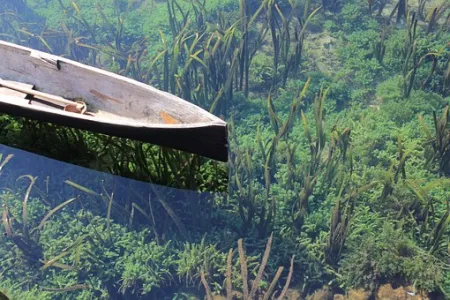An interview with Phillip P.A. Staniczenko on collaborating across disciplines with Steven M. Alexander
Former SESYNC Postdoctoral Fellows Phillip P.A. Staniczenko and Steven M. Alexander understand well the rewards and challenges of interdisciplinary science. While at SESYNC, the two researchers became familiar with each other’s disciplines and approaches to research, ultimately spurring an interdisciplinary collaboration. Together they investigated how social influence impacts the decision-making of artisanal fishers, who, rather than industrial trawlers, make a living using fish pots submerged near the shoreline or hooks and lines cast from small boats known in the Caribbean as canoes. Their findings were published last week in Fish and Fisheries.
Staniczenko, now an assistant professor at City University of New York, Brooklyn College, recently reflected on his experience working with Alexander, now a science advisor at the Canadian Department of Fisheries and Oceans.
So grab a cup of coffee, settle in, and hear how Phillip’s time at SESYNC laid the foundation for a successful interdisciplinary collaboration. He’ll explain how he was able to navigate the sometimes unpredictable waters of the collaborative process without feeling like he was stuck in a canoe without a paddle.
Q: How did you meet Steve and how did your collaboration start?
We were both postdocs at SESYNC and would often go for coffee at the local roastery with other postdocs to discuss seminar topics, but mainly to complain about the academic job market. It was at one of these outings that I learned Steve used to interview fishers at Bluefields Bay, an artisanal fishery in Jamaica, to build and then study the social networks of their relationships. We got talking about how the friendships among fishers could influence what they would catch, and how what they would catch would impact the bay’s food web, which in turn would affect the availability of fish for the next season. We thought it would be cool to model the whole system as one big network.
Q: How did that turn out?
Well, we’re not there yet, but we’ve made a good start. We began by trying to come up with a more specific question to focus our discussions. We homed in on the question of whether a fisher’s catch portfolio (what species they targeted) could be explained by who they shared information with. At the time, I’d been developing a new method relating competitive and facilitative interactions among plants to their geographical distributions and realized that the same approach could be used to relate social ties to catch portfolios. After some reworking of my code, we had a prototype method ready to go.
Q: And?
After a lot of back-and-forth between myself and Steve, tweaking assumptions here and there, we settled on a collection of models we were both happy with. We cranked the handle, parsed the results, and found we were able to confirm our hypothesis that social ties could explain catch portfolios. I’m happy to say we can finally share our findings with the wider research community.
Q: Congratulations! I’d like to learn more about your collaboration. What has been the most enjoyable aspect of working together?
Seeing Bluefields Bay through Steve’s eyes (his enthusiasm is contagious) and learning about his approach to asking questions.
Q: What has been the biggest challenge?
I have a bad habit of assuming Steve knows exactly what I’m talking about all of the time. I’d often go on a roll about some change to our method and how it changes results slightly and our interpretation in this way or that, only for Steve to go, “wait, wait, slow down, let’s go back to that thing you said earlier…
“…what’s a likelihood function?”
But we got there in the end.
Q: What was the biggest benefit?
Having someone with a completely different perspective, motivation, and set of skills to bounce ideas off. Building a model is like sketching a comic strip. Most of time you’re just concerned with drawing a picture that someone else will recognize. Working with Steve, someone who’s seen first-hand what you’re modelling, helps you identify those small details that maybe, just maybe, when shaded just right, will help your comic strip get a laugh.
Q: How has this experience changed how you work with others?
I try to listen more. And I try to think carefully about what I’m hearing. Often, I’ve been quick to ignore what I haven’t immediately understood. Academics like to ramble, so you’ve got to concentrate to find those golden nuggets. But if you do, then you’ll become very rich. (Metaphorically of course, we’re still academics, after all.)
Q: What’s your advice to people thinking of doing interdisciplinary research?
Work with people you get on with—you only make progress with a lot of patience and a healthy dollop of humility. This type of research isn’t easy and can take a long time, but it can also be very fun and endlessly rewarding.
